Reserve Bank of Australia Annual Report – 1989 Monetary Management in 1988/89

Monetary policy, since the last quarter of 1987/88, has aimed to restrain growth of domestic spending to a rate more consistent with lower inflation and with the economy's capacity to produce. It has been slow to take effect; the strength of demand was underestimated for much of the year. Consequently, the gap between domestic spending and production, which began to widen in 1987/88, grew further in 1988/89. There was a sharp deterioration in Australia's international trade accounts despite favourable world trade growth and high commodity prices. Inflationary pressures were kindled, and were particularly evident in sectors such as housing, where demand could not spill over into increased imports.
As in previous periods of strong economic expansion, growth of domestic spending has brought about a more-than-proportionate rise in imports. Policy adjustments in recent years, whether microeconomic or macroeconomic, have not been reflected so far in a reduced propensity to import. This reflects the necessarily slow pace of supply-side change, the high level of capacity use, and the strong growth of investment spending.
Tighter monetary policy, by slowing aggregate demand, will tend to slow imports. It also raises the cost of investment through higher interest rates and a higher-than-otherwise exchange rate, and thus tends to slow the likely growth of future productive capacity. Nevertheless, net exports are unlikely to grow while domestic demand absorbs so heavy a proportion of available supply.
When the Bank tightened policy early in the June quarter of 1988, it was becoming obvious that the sharp fall in share prices in 1987 was having little impact on the real economy, as distinct from the financial sector. Fiscal policy was tightened in the Commonwealth budget in August, and monetary policy was further tightened through the first half of 1988/89. However, private demand continued to grow rapidly despite the restraints of policy.
1 SPENDING, PRODUCTION AND TRADE
1984/85 prices 6-month-ended growth


In the two crucial areas of inflation and the balance of payments, no progress was made over 1988. In fact, the outlook for the balance of payments was worsening despite the terms of trade having shifted in our favour. Further sharp adjustments of monetary policy were made in February/March 1989 and again in May.
Towards the end of 1988/89, there were limited signs that the economy was responding. Property markets, both residential and commercial, had turned down, and some highly-geared companies were being forced to make adjustments. Nevertheless, the economy remained resilient and the Bank at times had to discourage tendencies for bullish sentiment in financial markets from bringing about an unwarranted easing of conditions.
The strength of spending throughout 1988/89 — sustained in the face of progressively tighter monetary policy — can be better understood in retrospect.
To an extent its genesis was in 1987. One thread was the failure to recognise at the time how rapidly the world economy was growing in the first half of the year, and how this soon would be reflected in rising commodity prices. Second, while the share-market crash of October 1987 significantly affected, and continues to affect, the financial sector, the real economy soon shook off its effects and, contrary to expectations, rapidly resumed strong growth. Hence, the attention given to maintaining financial system stability allowed demand to gain further momentum until policy tightening began in the June quarter of 1988.
Many countries shared in these general features. In Australia, however, market sentiment was very buoyant in the first half of 1987, encouraged by the Government's early foreshadowing of its May Economic Statement. The rise and subsequent fall of the share market were greater than in other developed countries. Monetary policy had made some attempt to slow the rise and, while it needed to do very little to guide the system through the subsequent sharp fall, monetary conditions were relatively easy at the beginning of 1988.
More generally, the growth of spending in 1988/89 can be viewed as an outcome of policies, including wage and tax arrangements, which had been aimed for several years at achieving a climate for expansion of the economy's productive capacity. Company profits were buoyant; household income grew strongly; and, with commodity prices continuing at the high levels reached in mid 1988, Australia's terms of trade and rural incomes improved further in 1988/89.
Reduction of the company tax rate from 49 to 39 per cent and the boost to business confidence by the Commonwealth's move into substantial fiscal surplus were further encouragements to investment. The outcome was an increase in investment in 1988/89 beyond the capacity of the nation's existing resources or its available savings. The spillover into imports and resort to overseas capital sources were inevitable.
The surge in private demand was not limited to business investment. Private consumption grew quite strongly in the course of 1988/89, in line with the increase in employment. Housing also boomed. Again, a number of factors contributed. Growth of household incomes and reintroduction of “negative gearing” buoyed demand for housing; loans for investment housing rose sharply as a proportion of the total. The cost of housing finance continued to decline until early 1988 and responded only slowly to the tightening of monetary policy after April 1988. Banks in particular were able to delay raising housing loan interest rates. The heavy shift of funds to savings accounts after the share-market crash in 1987 meant that the average cost of their funds increased only slowly. Some banks competed vigorously to increase their share of the housing finance market; housing loans attract a favourable risk weighting under the Bank's newly-installed formula for assessing capital adequacy.
The general confidence in the community, stemming in part from the muted impact of the share-market fall, the fiscal surplus incorporated in the 1988 Budget, and the continued strength of commodity prices, also contributed less tangibly to the buoyant private demand.
The turnaround in the public sector borrowing requirement undoubtedly had a direct impact on the balance of domestic spending and saving. However, this was offset by the sharp rise in investment in housing and construction as well as in business plant and equipment. The net shortfall of domestic saving became, in 1988/89, large enough to cause an increase for the first time since 1985/86 in Australia's net borrowing from abroad — the counterpart of the current account deficit — as a ratio to GDP.
Australia's external debt rose, despite a sizeable reduction in that part owed by the Commonwealth. The external debt servicing burden increased, making the task of correcting the current account deficit position that much more difficult. The higher level of Australian dollar assets held overseas also adds to the potential for sharp movements in both the exchange rate and security yields in response to shifts in demand for such assets.
Monetary policy was sometimes described as the “balancing factor” in the overall policy package, i.e. bridging the gap between macroeconomic objectives and the setting of other policies. In the event the gap was wider than anticipated. Monetary policy was tightened progressively during 1988/89 but it was only towards the close of the year that some response could be confidently asserted. Meanwhile, the inflation outlook and the deficit in the current account of the balance of payments both deteriorated.
2 FLOW OF FUNDS
% of gross domestic product lending(+)/borrowing(−)

Retention of the present stance of policy should produce more significant restraint of spending as 1989/90 progresses. Whether this will also be sufficient to lay the groundwork for winding back the current account deficit is uncertain; there are risks that it may not. These risks will be much greater if there is a substantial slowing of world growth and a decline in commodity prices.
The combination of high domestic interest rates and general confidence prompted a strong rise in the Australian dollar in the first half of 1988/89. The Bank tested the strength of demand for the currency without vigorously resisting the appreciation. Priority in policy was given to preserving tight financial conditions to bring domestic spending under control. It was acknowledged that the higher dollar was likely to erode some of Australia's trade competitiveness, but the Bank's assessment was that longer-term competitiveness was more at risk from inflationary pressure than from a, possibly temporary, rise in the currency. The higher exchange rate was not translated fully into slower growth of prices in Australia, as many had expected. The excess growth of domestic demand meant that not all importers were under pressure to reduce prices in order to maintain sales. There was also a perception by some that the high value of the dollar would not be sustained.
In February 1989, financial markets became increasingly aware that economic conditions were not responding to existing policies and this precipitated a sharp fall in the currency. Again, the Bank did not seek to resist market views. Its operations were designed to keep order in the foreign exchange market and to discourage any tendency towards an excessive loss of confidence in the Australian dollar. The depreciation reversed part of the loss of competitiveness caused by the currency's rise during 1988. The lower exchange rate was not expected to have a substantial impact on inflation, given the tight overall setting of monetary policy. (See next chapter for additional detail on foreign exchange market activities.)
Issues for monetary policy
In the past year there has been considerable debate on the techniques of monetary policy and, in particular, on the role of the financial aggregates as policy indicators.
It is generally agreed that monetary policy cannot proceed solely on firm economic data (production, demand, prices). The lags in availability are too long. Policy makers need to be guided by partial indicators which, as in 1988/89, may not always be conclusive or reliable.
Financial aggregates, particularly monetary aggregates which were more widely used some years ago, have more recently become very difficult to interpret.
During the 1980s, the various effects of financial deregulation have disturbed growth patterns of financial aggregates. Different series have had widely disparate growth patterns (see next chapter). More fundamentally, however, there has been no stable or predictable relationship between growth of particular financial aggregates and growth of activity and prices over the past decade. The value of the monetary aggregates depended upon the theorem that movements in them preceded movements in economic activity and prices. Experience of the past decade suggests this is no longer consistently the case. The financial aggregates now tend to react to, and follow, movements in activity.
It may be that the situation will change in the future but, for the time being, the use of financial aggregates as a sole guide to monetary conditions is not appropriate. The Bank relies on a wider range of real and financial indicators to judge the state of the economy and to assess inflationary prospects.
There has also been some uncertainty about the relative roles to be played by various elements of policy. As mentioned above, monetary policy is sometimes called the “balancing factor”, suggesting some degree of possible trade-off with other elements of the policy mix. In the early months of 1987, it was judged that fiscal tightening and wage moderation presented the opportunity to lift some of the burden from monetary policy. In the event, the exuberance of markets led to an easing in monetary conditions before the other policies had taken up the slack. In normal circumstances, the effects of this market anticipation might not have been troublesome. However, it coincided with an unforeseen resurgence in demand world-wide and in commodity prices. The experience illustrates a need for great caution in adjusting monetary policy in response to decisions on, rather than the results of, other policies.
The economic environment[1]
The world economy
Industrial countries continued to grow quickly in 1988/89.
This was the fifth year in succession of solid economic growth and, in many countries, signs of capacity constraints began to emerge. Inflation, held in check at an average 3½ per cent over the previous five years, became the focus of policy during the first half of the year.
Signs of increased inflation in the major countries began to show around the middle of 1988. By late 1988, it had risen to an average of about 4 per cent. In some countries, such as Japan and West Germany, increases were from low bases. Overall, however, inflation continued to rise to about 5 per cent on average in the first half of 1989.
3 AUSTRALIA AND THE MAJOR SEVEN INDUSTRIAL COUNTRIES


There was a slowing and even some stalling in the correction of fiscal and external imbalances in and between major economies. In particular, there was little progress in reducing the U.S. fiscal deficit and little apparent prospect of major tax or expenditure adjustments in the near future. Current account balances of the major countries were, for the most part, little changed from outcomes a year earlier. The exception was the U.K. where the trade deficit widened. As in Australia, the strong rise in economic activity generated rapid growth of imports.
Against this background, monetary policy was tightened in 1988/89 in a number of major countries. In the U.S., increases in interest rates began early in 1988. In the following 12 months, the federal funds rate rose from around 6½ per cent to just under 10 per cent, but declined a little towards the end of the year. Other interest rates followed a similar pattern over the year. Monetary tightening began a little later but was more pronounced in the U.K., where the acceleration in inflation was sharpest; the 3-month interbank rate rose from around 8 per cent in the June quarter of 1988 to around 14 per cent in June 1989. In Japan and West Germany, where risks of price escalation were less acute, conditions also tightened after June 1988, at least partly in response to exchange rate concerns.
Over the second half of 1988/89, there was some evidence of slowing in the pace of economic activity in the major economies. However, experience diverged widely from country to country. In the U.S., growth of industrial production and employment fell from the high rates recorded in 1988; inflation picked up further, but the evidence of slower growth contributed to the decline in U.S. interest rates after March. In the U.K. too, production was subdued. In West Germany and Japan, however, activity continued to expand; inflation rose further in both countries.
Commodity prices, measured in terms of SDRs, were broadly steady during 1988/89 following a large rise in the previous year. Lower prices for wool were offset by rises in prices for wheat, beef, iron ore and steaming coal. Reflecting movements in the exchange rate, commodity prices measured in Australian dollars fell in the first half of the year, but rose after the sharp depreciation of the currency in February. Australia's terms of trade continued to improve, though at a slower pace than in 1987/88; by early 1989, the terms of trade were about 30 per cent up from their trough in March 1987. Growth in the major countries boosted world trade, as did the relative stability of international exchange rates. All in all, this gave Australia a more favourable international environment than in many other recent years.
4 TRADE BALANCES
% of gross national product

5 INTEREST RATES

The Australian economy
In Australia, the rate of inflation, as measured by the consumer price index, exceeded 7½ per cent over 1988/89, slightly higher than for the previous year and well above the average for O.E.C.D. countries. (The published figures were boosted, particularly in the September and December quarters of 1988, by a tendency for the index to overstate the effect of rapid rises in house prices and in home mortgage interest rates on the cost of living; the calculation of the index was changed in the March quarter 1989 to remove this overstatement of housing costs.)
The external accounts deteriorated sharply in 1988/89. The current account deficit increased to $17¾ billion, or about 5¼ per cent of GDP, compared with $12¼ billion or 4¼ per cent of GDP in 1987/88. Net external debt was an estimated $110 billion in June 1989; this was equivalent to about 33 per cent of GDP, some 2 percentage points higher than a year earlier. Increased external debt led also to a rise in the costs of debt servicing to about $9 billion in 1988/89, equivalent to about 17 per cent of Australia's total export receipts.
The deterioration of Australia's trade performance reflected the rapid growth of domestic spending, which greatly exceeded growth in the economy's capacity to produce goods and services. Domestic producers faced high levels of demand and were under little pressure to restrain costs and prices. Imports rose sharply, especially in those industries — such as motor vehicles — in which domestic producers could not quickly increase supply. Exports were virtually flat; after running down stocks in the previous year, rural export volumes were lower, but exports of non-rural commodities and manufactures rose.
6 TERMS OF TRADE AND CURRENT ACCOUNT

7 NET EXTERNAL DEBT
% of gross domestic product
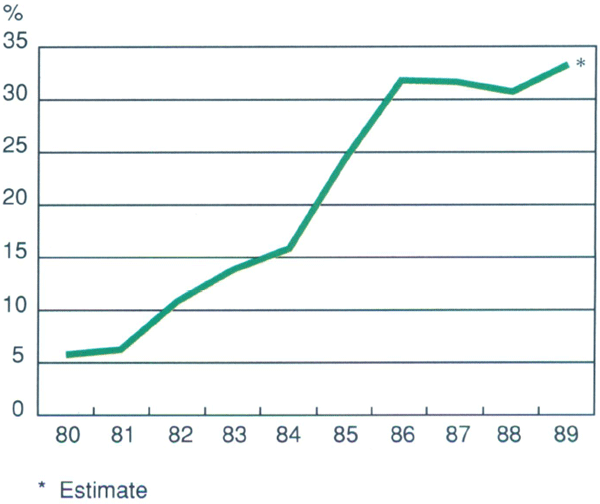
Housing and business investment were the components of spending which grew most quickly in 1988/89. Dwelling investment rose sharply in the first half of the year, accompanied by rapid rises in house prices in some cities, especially Sydney. Activity steadied in the second half of the year, though remaining at a high level. Business investment, particularly spending on plant and equipment, was also very strong and directly accounted for a large part of the growth of imports in 1988/89.
Private consumption grew strongly, though with little rise in spending per head of population. Household income growth was due largely to the increase of employment.
8 TRADE
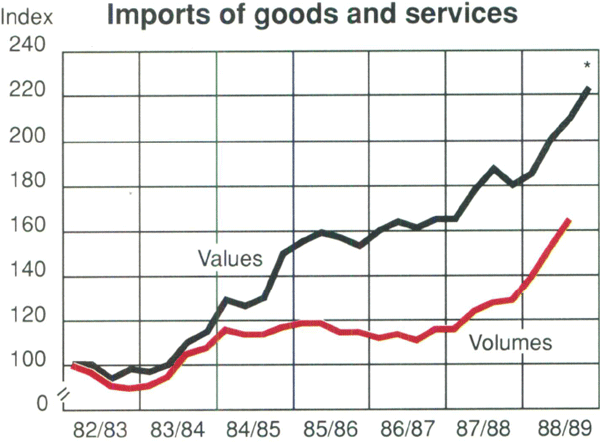
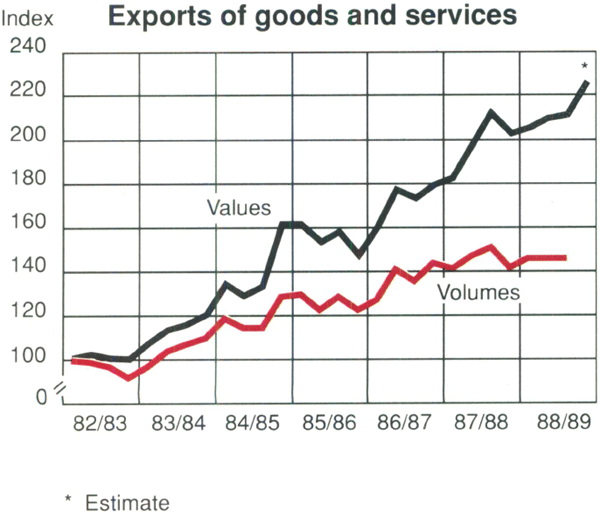
9 HOUSING
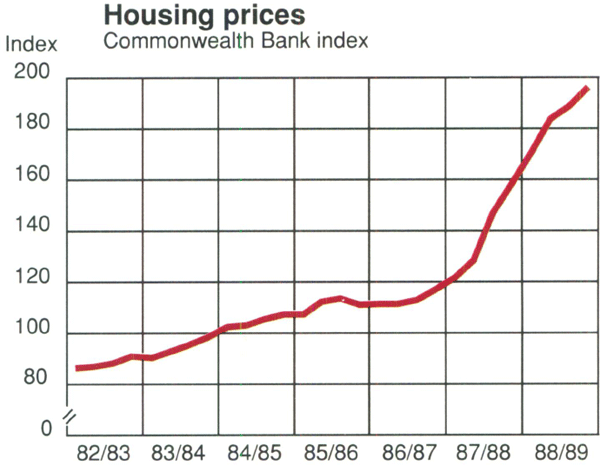
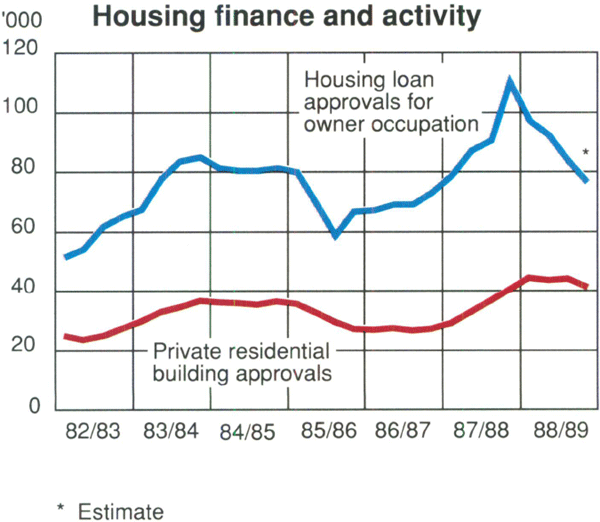
The labour market was very tight throughout 1988/89. Employment grew by 4½ per cent, and unemployment fell to 6 per cent of the workforce in June 1989 compared with 7¼ per cent a year earlier. Shortages of skilled labour were reported in some industries, especially in the construction sector. Growth in nominal earnings was stronger than in the previous year.
Monetary and credit aggregates grew rapidly. M3 rose by 27 per cent and broad money by 19 per cent in the year to June 1989. Both were boosted by removal of the Statutory Reserve Deposit requirement (see page 31), which had held down their growth rates over the preceding two years. The resulting increase in bank deposits was partly at the expense of the non-finance sector's holdings of bank bills and of Australian dollar assets held by offshore investors, neither of which is included in M3 or broad money.
The credit aggregate was not directly affected by the Statutory Reserve Deposit change. Credit extended by all financial intermediaries grew by 21 per cent in the year to June 1989, compared with 25 per cent in the previous year.
More details on developments in financial markets are in the following chapter.
10 PRIVATE CAPITAL EXPENDITURE
% of gross domestic product 1984/85 prices
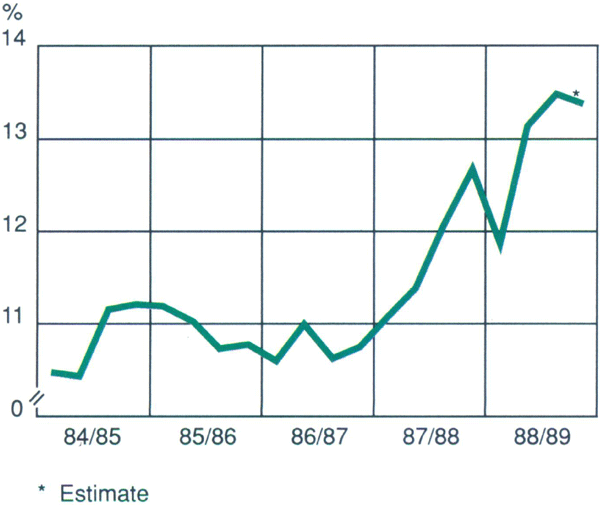
11 LABOUR MARKET
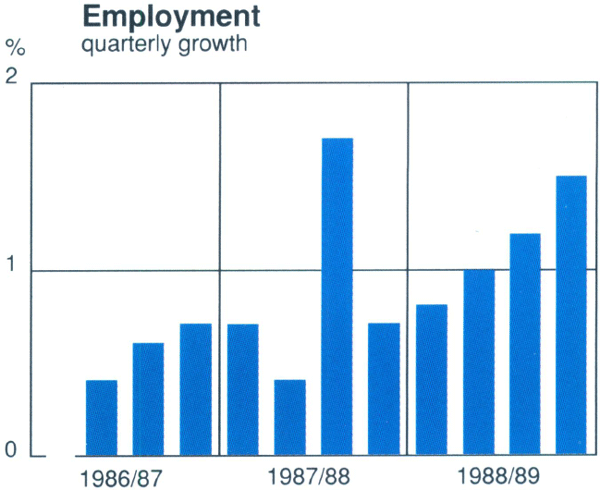
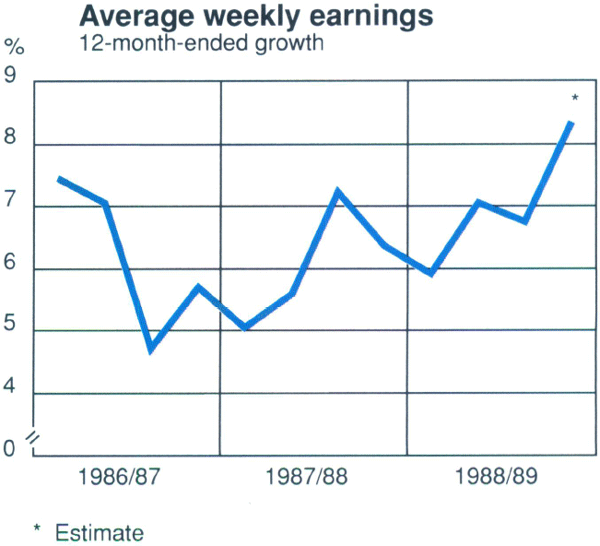
Footnote
*Regular commentaries in the Bank's Bulletin provide further details of economic developments during the year. [1]